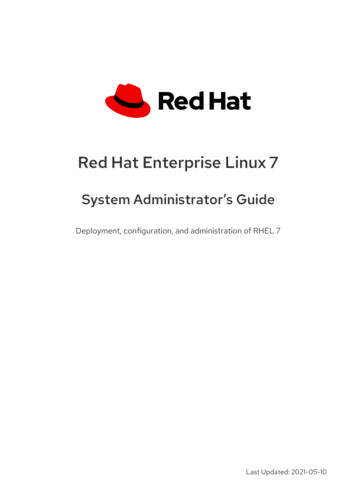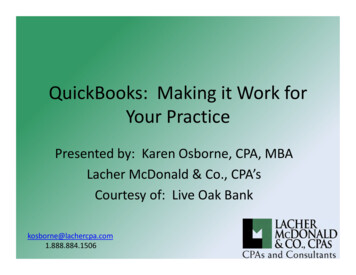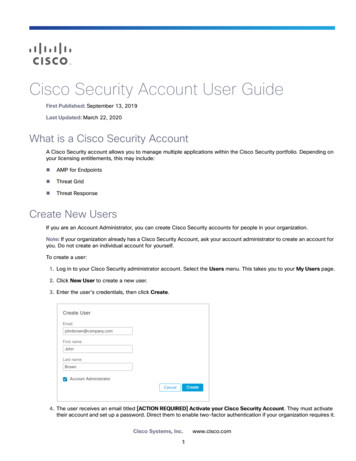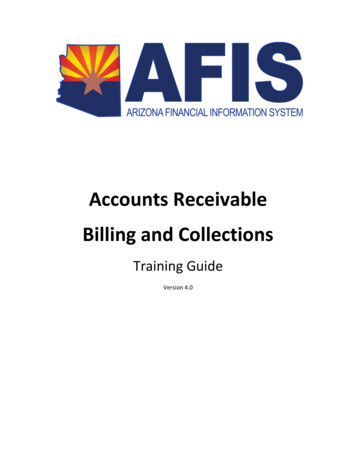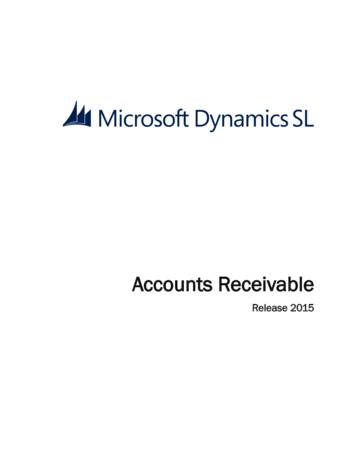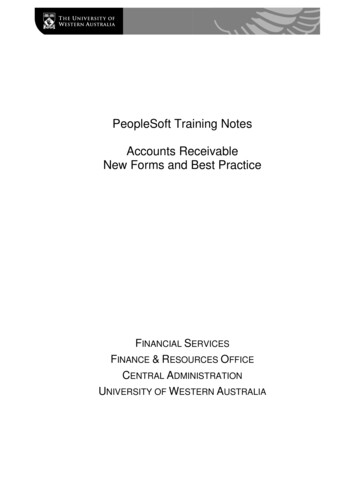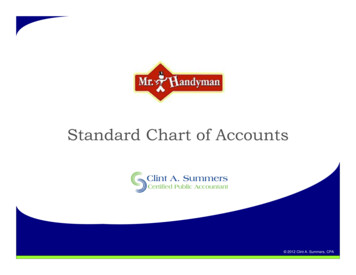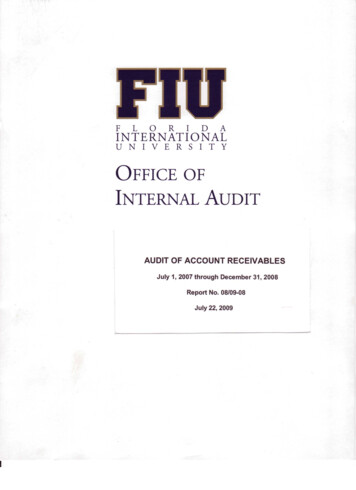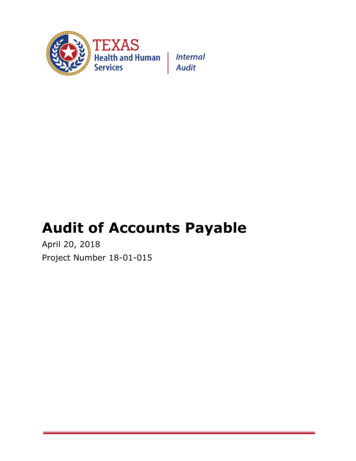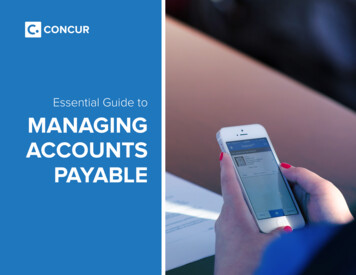
Transcription
Essential Guide toMANAGINGACCOUNTSPAYABLE
Table ofContents03Introduction06The true cost of invoice management11Moving to the cloud is the answer17Common misconceptions21The ideal invoice management solution24What does it look like once I’m automated?27Concur solution
Introduction
Invoice processing is brokenThe old way of doing invoices is slowing your peopledown and robbing your company of resourcesIf your company is like most, your accounts payable processingcould use a lot of help. On a typical day, invoices are sentto your AP department via email or snail mail (or worse, sentdirectly to your employees) and get lost in the shuffle. When aninvoice isn’t lost on an employee’s desk, your AP departmentlikely can’t pay it until it is compared to a PO or reviewedand approved by the person who ordered the items andtheir manager. Worse is when that missing data sends youremployees on a search mission throughout multiple paper files,email chains and documents making it almost impossible to findexactly what is missing.47%4 l Essential Guide to Managing Accounts Payable— Pay Stream, 2014 Invoice and WorkflowAutomation ReportWith such a manual process, it’s virtually impossible for youremployees to spend time doing what really matters—their job!These mundane tasks—searching for invoices, chasingapprovals, coding invoices and correcting data—take upvaluable time. You know all too well that lengthy delaysare common with invoices and have huge financialrepercussions for your company. And on top of all this,your C-suite and strategic planners have an incompleteview of the company’s finances.of companies surveyed do notmeasure their accounts payableprocessing costs.65%With invoices responsible for upto 65% of your operational costs,why are you managing them withinadequate, outdated tools andprocesses?—A berdeen Group, From the Shadowsto the Forefront: AP Automation andthe Strategic Vision, October 2013
Invoice processing is brokenThere’s a huge disconnect between the strategic vision of the C-suite and the cash flow data of theback office. But many haven’t realized there’s an easy fix—moving to the cloud.This guide lays out everything you need to know, fromthe pitfalls of invoices via spreadsheets and emails to theopportunities afforded by moving to the cloud. Use this eBookto become a persuasive agent for change with a vision forimproving your business.Remember, no one is asking you to fix this. But they’ll be happyyou did.53%More than one-third of businesses consider difficultyfinding or managing paper-based documents to be aleading obstacle to achieving their business goals.— Aberdeen Group, From the Shadows to the Forefront:AP Automation and the Strategic Vision, October 2013According to 53% of SMB AP departments,migrating off paper-based processes is thetop priority, followed by improving processingefficiency (34%), both of which go hand-in-hand.— Ardent Partners, The State of AP in the SMB Market,November 20135 l Essential Guide to Managing Accounts Payable
The true costof invoicemanagement
The true cost of invoice managementYour company is actively working to improve across the board: from increasing productivity toensuring high customer satisfaction and building lasting business partnerships. In order to addressall of the changes your company is making, it needs to run like a well-oiled machine. Your currentprocesses may seem good enough, but the truth is, they aren’t. They’re costing you in ways youdon’t even realize.Managing cash flow with manual invoice processing is just oneexample of a process that isn’t quite good enough. 7 7% of invoices received by companies are in a manualformat: hard copies, PDF, email or fax.1 M anual invoices are one big headache. There’s no visibilityfor forecasting purposes, no insight into spend and no wayto learn how to save money! O n top of that headache the average cost to processan invoice is 13.50!1 T he spreadsheet technology your business relies on toapprove and track invoices is more than 30 years old. That’sright—30 years old! You wouldn’t rely on such outdatedmeans anywhere else in your business. Why here? Notonly are spreadsheets outdated, but they can also causeproblems—they lead to transcription errors, decentralizeddata and the inability to quickly and accurately report oncash flow. As if that weren’t enough, it takes a tremendouseffort to check and consolidate spreadsheet-based invoicecoding and approvals with payments.There has to be a better way!Manual invoice processing using spreadsheets is painful. It sucks up time, money and resources. Why does this matter?You’re losing a lot of money. Your employees hate the process; your suppliers hate the process. It’s painful, inaccurateand slows down business for all!1Ardent Partners, 2013, State of AP in the SMB Market7 l Essential Guide to Managing Accounts Payable
The true cost of invoice managementHere’s the true pain your back office is feeling. For every invoice that comes throughyour AP department, this three-part process takes place.Receive, search, enterFirst, invoices may or may not come to your AP department.Too often, invoices are sent to the employee who placed theorder, and sit on his or her desk. After receiving an invoice, thefirst thing your back office does is manually enter the data—resulting in errors and wasted time. It’s especially bad wheninvoices are incomplete, forcing your employees to searchfor information. Many companies use electronic data captureinstead of manual data entry for their invoice processing.However, only 15% of SMBs have the ability to electronicallycapture data. Most SMBs simply scan invoice images forarchiving—not for data capture.242%of SMBs have expressed interestin automating invoice processing— 2013 Ardent Partners, The State of APin the SMB Market2Ardent Partners, 2013, State of AP in the SMB Market8 l Essential Guide to Managing Accounts PayableAn all too familiar situation: you receive an email withmultiple attachments. Most of the time you quicklyglance at the attachments barely viewing them,never downloading them and certainly not filing them.What happens when an invoice is buried in thoseattachments? Moving your invoice managementprocesses to the cloud ensures you’ll never needto find out the answer.
The true cost of invoice managementPaymentPaper checks are common in the world of SMBs. Theirprevalence, however, doesn’t make up for the fact that they’renotoriously inefficient and time consuming. When you aremanually processing invoices, you can’t optimize the use ofePayments, or easily use credit cards to pay vendor invoices.This means you lose efficiency, visibility and rebates. Asmore and more suppliers accept and prefer ePayments,you are left spending more time and money on an obsoletepayment method.Although ePayments are becoming more and more common,SMBs face challenges when moving away from paper checks.SMBs surveyed raised these concerns: 54% Integration to accounting systems 51% Convincing suppliers to accept ePayments 37% Privacy/Security of bank account information 34% Lack of standardized format for remittance information 26% Shortage of IT resources for implementation—Ardent Partners, 2013 State of AP in the SMB Market9 l Essential Guide to Managing Accounts Payable
The true cost of invoice managementWith the average cost of manually processing one invoiceat approximately 13.50, think of what you could do with themoney you save money you save with cloud automation. Hireanother sales associate, attend the big conference, invest inR&D or grow your business!Top AP Challenges43%Lengthy processing times33%High invoice processing costsFor an SMB, it is significantly more valuable for an accounting/finance resource team to spend time focusing on a key arealike cash management as opposed to manually processingtedious cash flow management.31%Lack of visibility into invoice and payment data30%Inability to capture enough early payment discountsSpreadsheets, multiple data entries, lost emails, piles of paper,unclear approval processes—they all get in the way of havinggood data. There’s a better way!20%Late supplier payments10 l Essential Guide to Managing Accounts Payable—Ardent Partners, 2013 State of AP in the SMB Market
Moving tothe cloud isthe answer
Moving to the cloud is the answerWhat if you could change the way your company handles invoices with one easydecision? You can! There’s an easier way to process invoices, and we think it’ll havea big impact on your business.You don’t have to use manual processes for invoices. Best-inClass companies have been able to streamline their workflowprocesses by investing in automation. Not only do Best-inClass companies process invoices at a fifth the cost of industrylaggards but also help their suppliers and/or buyers get onboard with automation.With manual invoice processing so costly, your company can’tafford NOT to automate. Without automation, your companyis suffering: V endors and AP harass your employees asking about statusof invoice payment or approval, distracting them from theirreal jobs.12 l Essential Guide to Managing Accounts Payable S enior management has limited visibility into cash flowand how you are spending your money. A P departments drown in a sea of paper, and spend all theirtime processing invoices instead of helping the businessmanage cash and vendor relationships. S uppliers have no visibility into when they will be paid,and potential early payment discounts are missed. C ontrols on spending and disbursement are not wellenforced, creating a risk of fraud or mistakes that costyour company.
Top 5 reasons to move to the cloudBest-in-Class companies focus on details in order to enhance their existing capabilities.Here are a few ways that moving your invoice processing to the cloud can propel your company:EfficiencyDrive efficiency through standardization.Manual invoicing keeps your AP department from hitting fullefficiency. After all—it’s impossible to fully standardize or scale amanual process, especially AP.3And while you may think your manual invoice processes areefficient and don’t need standardization, the truth is that theyseriously hinder your employees’ productivity.Your employees know this struggle all too well. Paperdocuments are hard to find and track. When a vendor sends aninvoice electronically, it can fall into the black hole of email—withlittle chance of return.3And when vendors submit an invoice with a PO and a contractattached, the amount of documents doubles while yourefficiency level drops.Automating the accounts payable process allows youremployees to focus on strategic tasks instead of mindnumbing ones. Rather than searching through files and pilesof paper, automation lets your employees find documents fast.Automating your invoice processes lets your AP departmentmake payments on time and avoid late fees!Get back the time it takes to manually process, approve and payinvoices. Your employees will thank you for it.The payments department essentially owns cash flow,which in turn is the lifeline of liquidity. If AccountsPayable (AP) is inefficient, an organization cannotaccurately forecast its financial position“A centralized structure with standardized andautomated processes is the foundation upon whichthe next level of efficiency and visibility within AP istypically realized.”— Aberdeen Group, From the Shadows to the Forefront:AP Automation and the Strategic Vision, October 2013— Ardent Partners, The State of AP in the SMB Market,November 2013Ardent Partners, The State of AP in the SMB Market, November 2013
Top 5 reasons to move to the cloudVisibilityWhat you don’t know can hurt you.Disciplined spending is critical for the success of everyorganization. To stay on top of cash flow, it’s essential thatcompanies have accurate and up-to-date AP information.It’s difficult to make the right decisions without the rightinformation. And, without the right information, you may runinto poor cash flow, a late payment charge, or even anerroneous or fraudulent payment to a vendor that hasn’tprovided the goods or services expected.Not taking action today has a direct impact on themost important part of your company: cash flow.14 l Essential Guide to Managing Accounts PayableChoosing which invoice to pay and strategically spacing outpayment dates is necessary for many SMBs. But when you can’tsee all of your spend data, it’s impossible to prioritize paymentsand set aside cash to help other areas of the business. Withoutvisibility, unforeseen issues or unexpected travel can throw awrench into the finances of any SMB.Stop sweating cash flow management each month. Spendthat time running and growing your business.
Top 5 reasons to move to the cloudBetter business resultsControl and complianceAutomating your invoice processes in the cloud will immediatelysave you money. With real-time visibility, you can avoid latefees, duplications and overpayments while taking advantageof prompt payment discounts.Increase control and compliance by using a cloud-based invoiceprocess. A well-defined, repeatable, standardized processeliminates guesswork and human error.With automation, you can more accurately forecast yourfinances and better manage cash flow. The inefficiencies inyour current paper-based manual process lead to neverknowing where your SMB stands, or where you will be nextmonth. Take the guesswork out of your finances.If the very lifeline of cash flow—accounts payable—can’t offer an accurate picture of your financial position, thenhow can you forecast and plan your strategic initiatives?If accounts payable ever wants to be seen as a strategicfunction, then it must address this issue first.62%of respondents cite theneed for expedited financialinformation delivery— Aberdeen Financial TransformationSurvey, 201315 l Essential Guide to Managing Accounts PayableAdditionally, the cloud lets you increase approval times. Forexample: an invoice is processed, prepared and ready forapproval. However, the employee who typically approves thesematerials is out of the office for an extended time. Use the cloudto make invoices easily accessible to everyone, even whenthey’re on the road.Stop wasting money on manual processes; increaseyour cash flow and revenue with more productiveemployees. You have an opportunity to save money,so why wouldn’t you?
Top 5 reasons to move to the cloudMobileYour employees expect to do all things mobile, including invoicemanagement. By automating your accounts payable processes,your employees will be able to remotely review and approveinvoices. And with companies adopting bring-your-own-device(BYOD) policies at an ever-increasing rate, it only makes senseto incorporate mobility with your invoice processes.A whopping 67% of SMBs say that mobile solutions and servicesare “critical” to their business. If your SMB isn’t in that majority,you will be soon.4Leverage mobile applications to make processing easierand faster. Mobile solutions can reduce hassle for travellingemployees while driving compliance with your policies.583%SMB Group research indicatesthat 83% of SMBs have alreadydeployed mobile apps to helpimprove employee productivityand 55% are using mobile appsfor specific business functions.—S MB Group, Top 10 SMBTechnology Trends For 201445In business, you’re often faced with either/or decisions. Do youtake steps to save money, or do what you can to make youremployees happy? By automating your invoice processes andmoving to the cloud, you can do both! Employees will be ableto easily approve invoices while on the road, your C-Suite willhave better visibility into spending and overall compliancewill increase. The potential return on investment of invoiceautomation for your SMB is high. Automation in the cloudrequires very little initial investment, is easy to set up and iseasy to use. There’s no reason for you not to automate.And don’t forget about people! Lost productivity and employeeresentment can be a huge cost for a company. Employeesdon’t like to waste their time manually processing invoices andtracking down the right people for approval. And vendor andsupplier relationships can be affected by late payments.Invoices can be easily approved from anywhere atanytime on a mobile device. As an added safety net,assign a ‘back-up’ approver. Ensure each invoice isreviewed and approved in a timely manner, evenwhen your employees are on the road.eWeek, Small Businesses Adopt Mobile Technology to Boost Business, August 30, 2013Aberdeen Group, End-to-End Visibility into T&E Expense Management: Mobility Comes to the Table, April 2013
Commonmisconceptions
Common misconceptionsYou know that automating your invoice management system in the cloud can easethe pain, but many people are hesitant to make the switch, raising objections like these:It will cost too much. F ALSE: You actually end up saving money by automatingin the cloud. According to Ardent Partners research,businesses can reduce their invoice processing costs upto 70% through automation.The cloud only makes sense forbig companies. FALSE: Cloud solutions are ideal for SMBs as they do notrequire significant IT resources or infrastructure and canusually be deployed in a short time-period with little orno upfront investment.Emails are the same as automation.“With Concur invoice, we wanted to see what was thecost per invoice. We used to go from maybe a 10 or 11 payment per invoice if you roll up all of the laborcost, filling everything. I think we’ve at least reducedthat by 50%.”—Western Governors University18 l Essential Guide to Managing Accounts Payable FALSE: Even with invoices sent electronically, invoices getlost in the black hole of email. Wasting time digging throughemail after email to find that one invoice can cost you morethan just your sanity.
Common misconceptionsIt takes too long to set up F ALSE: With Concur, you can be up and runningwithin weeks.An automated system can take the jobs ofthe finance team.35% FALSE: By simplifying and streamlining your invoiceworkflow, your finance team has more time to focus onmore strategic activities. “ After Concur Invoice, the [invoice management] process ismuch more automated and streamlined, and so employeesare not spending time trying to manage the queue and wecan easily find bottlenecks through Concur reporting.”—Career Builder19 l Essential Guide to Managing Accounts Payable22%of SMBs cite the inability toreconcile accounts and paymentsin a timely manner as a leadingmarket pressure.—A berdeen Group, AP Automation and theStrategic Vision, 2013Don’t miss out on discounts! 22%of companies say they are unableto capture early payment discountsbecause their invoicing system isnot automated.— Aberdeen Group, From the Shadows tothe Forefront: AP Automation and theStrategic Vision, October 2013
Assess your readiness for changeThe biggest barrier faced by companies when it comes toautomating processes and improving efficiency is resistanceto change. 44% of businesses cite resistance to changeas the main obstacle they face when working to improvecompany efficiency.Don’t let this be a barrier to automation. Automation iseffortless—easy to set up, easy to use and easy to see theresults. While it’s normal to expect some level of internalresistance, it’s worth it and your co-workers will thank youin the long run.20 l Essential Guide to Managing Accounts Payable“To negate the threat of creeping inefficiency eatinginto profitability, the owners and managers of SMBsshould tackle institutionalized resistance to change ”— The Economist Intelligence Unit, 2013
The ideal invoicemanagementsolution
The ideal invoice management solutionGone are the days when only large enterprises could benefit from technology and processautomation. The cloud has changed the game by making technology more accessibleand affordable.Use these features to build a solid business case for change.Approval processEase of useGathering invoices is only the first part of the process. Yourinvoice management system should also help you obtainmanagement approvals—even if the approver is out of theoffice. A solution that automatically assigns a back-up approverhelps expedite invoice processing, and avoids late fees.Look for an invoice management solution that can simplify theapproval process and move invoices along with clear rules,permissions, and escalations. The system should be intuitiveand productive for both the AP department and the employeeswho review or approve invoices.Mobile supportMake sure you and your employees can access the solution viamobile devices. This is key to improving processing times andkeeping on-the-go employees satisfied.Invoice capture optionsCompanies and suppliers have different needs and capabilitieswith invoices. Look for a variety of options for invoice capture,including eInvoices and scan and OCR technology. Ensure thesystem works effectively for all of your invoice situations.22 l Essential Guide to Managing Accounts PayableData captured from invoices can trigger automaticalerts that immediately notify the appropriate partywhen a specific action needs to be taken. Authorizedpersonnel can review, annotate or assign the invoicesfrom any location at any time, removing the delayof interoffice mail and the need to wait forauthorized persons to return to the office torender needed approvals.
The ideal invoice management solutionComplete visibilityCash flow managementWhether your business has one employee or 500, you needto track where you are spending your money. Regularly gettinginformation on expenses, invoices and cash flow can help youmake changes that save your company money and time.Automation through the cloud allows companies to managetheir free cash. Through early payment discounts, companiescan save large sums of money, while their suppliers benefit fromfaster collection of receivables. With more capital available andincreased revenue from discounts, companies can invest in newopportunities, improve their standing in their industry and growtheir business.WorkflowAn automated workflow provides an overview of the status ofall invoices and gives authorized users the ability to track allactions related to an invoice. Queries and reports can be pulledquickly and easily with an automated workflow inside yourinvoice management system. You can create an electronicaudit trail in minutes instead of hours, and that helps acompany comply with audits and regulations and meetservice level agreements.Integration with AP systemsBecause invoices come to your AP department in varyingformats, it’s best if your software integrates with third partysolutions. That integration lets you extract and share databetween applications, and maximize productivity.23 l Essential Guide to Managing Accounts PayableWith the proper capture and automated workflowsolution, large volumes of invoices and theirdiscount and penalty information can be enteredas payables within hours of their receipt, thenapproved and processed in time to capture alldiscount opportunities.
What does itlook like onceI’m automated?
What does it look like once I’m automated?Best-in-Class companies have expedited the invoice process—from data capture to disputeresolution—to better understand and enhance the customer experience. They are five timesmore likely to capture early payment discounts and spend only one fourth of the time processinginvoices compared to other companies.6Invoice automation adds up - to happier employees, better cashflow, faster processing, greater compliance, more visibility, moretime to meet with prospects and customers.Case Study: Whidbey Island BankWhidbey Island Bank doubled in size through new acquisitions,but couldn’t afford to double the time spent processing invoices.With Concur, the bank processes invoices five times faster thanwith manual invoicing.“We’re paying our invoices so quickly now, we have virtuallyeliminated calls from vendors inquiring about invoice status,”says Darin Johnson, VP and Controller. “We’re incrediblyimpressed with Concur,” says Johnson. “They understand ourresources and limitations, and they actively see and meet ourneeds. I expect a lot from my vendors, and Concur rises toevery challenge.”6Aberdeen Group, AP Automation and the Strategic Vision, 201225 l Essential Guide to Managing Accounts PayableCase Study: Getty ImagesGetty Images is among the world’s leading creators anddistributors of still imagery, video, music, multi-media productsand digital content. With customers in more than 100 countriesand employees all around the world, Getty Images needed toimplement centralized AP automation to get control ofcompany spend.Getty Images identified specific needs: decrease inaccurateentries and provide easy access that would allow for multiplecurrencies around the globe.“It used to take 15-20 days to get an invoice through the cycle,”says Senior Finance Manager Elizabeth Sumption, “and now ittakes five days.”
What does it look like once I’m automated?Case Study: Elizabeth ArdenElizabeth Arden is a prestigious global beauty productscompany with brands sold in more than 120 countries. Theyrecognized the need to be more cost effective and identifieda way to do so: reduce the number of invoices processed asa company through an integrated system.Elizabeth Arden chose Concur Invoice to automate their invoiceprocesses while decreasing processing time, increasing visibilityinto employee spend and developing an integrated system witha custom interface.Elizabeth Arden set themselves up for success by choosing asolution that let them be more cost-effective and provide bettercustomer service.26 l Essential Guide to Managing Accounts Payable “We’ve seen around 20% in savings in theexpense and invoice processing area.”—John Viola, Elizabeth ArdenBuild support in your organization for an automatedcloud solution: download the mobilizer’s guide:“How to secure buy-in”.Download the guide
Concur solution
Concur solutionBecome a Best-in-Class company with a Best-in-Class solution. Concur lets you see the bigpicture, so you can focus on what matters most.How Concur invoice management worksConnected: Connects you to every dime of spend—whereverit’s spent—by integrating all the data outside the system intothe system. Integrates with key systems like your ERP Open to suppliers and networks V alidates sales & use tax with ONESOURCE appfrom Thomson ReutersTransparent: Lets you see what you need to see—from everyitinerary to every invoice—so you can make decisions BEFOREthe money is spent. V isibility into ALL spend whether via invoice, P-card,corporate card or cash Optimize both managed and unmanaged spend V iew consolidated vendor spend across both T&Eand invoicesEffortless: Make your spend process work without all the work,effortlessly managing the details for your company and your28 l Essential Guide to Managing Accounts Payableteam, so it’s easy for everyone to manage their spend. O ne system, login and UI for your Concur Travel, ConcurExpense and Concur Invoice users to use and learn Mobile approvals for budget managers on-the-goConcur’s unique differentiators: L ow upfront costs and the ability to be up and runningin weeks, not months. S cales from as few as 100 invoices per month toover 40,000. S hared web and mobile applications with Concur Traveland Concur Expense, means easy adoption and use bybusy managers across your business. P owerful analysis tools provide insight into all forms ofemployee spending—card, out of pocket, and invoice‚—in a single, unified environment. O ptions to use OCR and invoice extraction technologyyourself, or outsource all invoice capture to Concur.
About ConcurConcur, a part of SAP, is the leading provider of spendmanagement solutions and services in the world, helpingcompanies of all sizes transform the way they manage spend sothey can focus on what matters most. Through Concur’s openplatform, the entire travel and expense ecosystem of customers,suppliers, and developers can access and extend Concur’sT&E cloud. Concur’s systems adapt to individual employeepreferences and scale to meet the needs of companies fromsmall to large.Learn more at concur.com or the Concur blog.Take a test driveLearn more
5 l Essential Guide to Managing Accounts Payable More than one-third of businesses consider difficulty finding or managing paper-based documents to be a leading obstacle to achieving their business goals. — Aberdeen Group, From the Shadows to the Forefront: AP Autom

